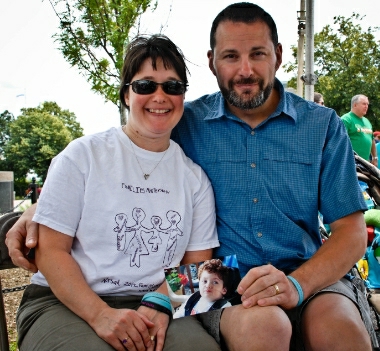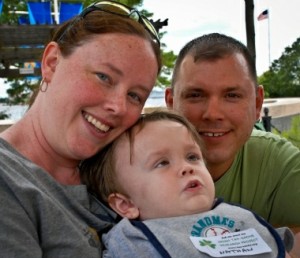When Cathy Mitchell’s son, Harrison, was diagnosed with Tay-Sachs disease, she and her husband, Jeff, were devastated–and more than a little confused.
“I thought Tay Sachs was a Jewish disease,” says Cathy. The Mitchells, who live in Langhorne, then learned that this deadly inherited disease, which cripples and kills, is common among people of Irish descent. As many as 1 in 50 Irish Americans is a carrier.
Children can only inherit the disease when both parents carry the trait; with every pregnancy, a couple runs a 25 percent chance of having a child with Tay Sachs and a 50 percent chance of having one who is a carrier but doesn’t have the disease. Cathy and Jeff Mitchell are both carriers.
“I didn’t even know I was Irish,” said Jeff Mitchell, who, with his wife and another couple–Aaron and Kathryn Harney of Downingtown—manned an information booth on Tay Sachs at the recent Irish Festival on Penn’s Landing. Mitchell hadn’t been close to his father’s side of the family and only learned after Harrison was diagnosed that his grandfather was Irish.
Like other children with Tay-Sachs, Harrison seemed like a perfectly normal baby when he was born. But at six months, he began showing troubling symptoms. “Harrison didn’t sit up. His muscle tone was weak,” says Jeff, a shop foreman at a truck equipment company. “When you would pick him up he would fall over. He startled to loud noises. He rolled over once and then never rolled over again.”
When Harrison seemed to have trouble seeing toys in front of him, the Mitchells took him to their pediatrician who, says Jeff Mitchell, “kept pushing it off on the fact that Harrison was born a month early,” implying he was experiencing normal developmental delays. Eventually, the Mitchells took their baby to a pediatric opthamologist who saw a cherry-red spot on his retina, a physical marker of Tay-Sachs.
The disease is a particularly cruel one. New parents come home with an infant who appears to be healthy and normal, but is lacking an important enzyme, hexosaminidase (Hex-A), that helps clear out fatty protein and other substances from the tissues and nerve cells of the brain. That regular housecleaning allows the infant to develop vision, hearing, movement, and other vital functions. For a few months, the Tay-Sachs babies grow and develop as babies do—cooing, reaching for toys, smiling, laughing, turning over.
But as those proteins build up in the tissues and nerve cells, a relentless deterioration of physical and mental abilities begins. Children lose their sight and hearing. Their muscles atrophy and they become paralyzed. Eventually, they’re unable to swallow, and they develop seizures and dementia. Most children born with Tay-Sachs die by the time they’re five. “They just slowly fade away,” says Jeff.
In 2010, Harrison Mitchell died just shy of his sixth birthday.
Unfortunately, most doctors don’t encourage any but their Jewish patients—particularly Ashkenazi Jews–to be tested for Tay-Sachs. They also may not recognize the symptoms when they see them in children like Harrison. Like the Mitchells, Kathryn and Aaron Harney saw doctor after doctor before their son, Nathan, now 18 months old, was diagnosed—again, by a pediatric opthamologist. “A lot of doctors looked and us and said, ‘Well, you’re first-time parents. . . .,” says Kathryn Harney, Nathan slouching on her lap, his hazel eyes wandering, unfocused.
Like the Mitchells, they Harneys didn’t know that Tay-Sachs is common among the Irish. After they were tested, Aaron Harney learned that he carries a strain common among French Canadians. “I didn’t realize I had French Canadian ancestors,” he says. Tay-Sachs is even more common in French Canadians and Cajuns than in the Irish—an estimated 1 in 27 carry the trait, the same as Ashkenazi Jews. Nathan also has a rare form of Tay-Sachs that more often occurs in older children. “That gives us some hope that he might survive longer,” says Kathryn.
There’s no cure for Tay-Sachs, but it can be prevented with genetic screening. The National Tay-Sachs & Allied Diseases Association of the Delaware Valley offers free Tay-Sachs screening to anyone over the age of 18. Researchers at Einstein Medical Center’s Genetics Division in Philadelphia are now conducting a study to determine an accurate carrier rate for Tay-Sachs disease in the Irish and to identify the most common gene changes in this demographic. If you qualify for the research project (you must have at least three Irish grandparents), you will be screened for free and also get genetic counseling to explain your results and discuss your options.
For more information about Tay-Sachs disease carrier screening or to participate in this study, contact Amybeth Weaver, MS, CGC at irish@tay-sachs.org or call 215-887-0877. You can also go to the website and download a brochure that explains the Irish connection to Tay-Sachs.
Eight weeks after Harrison died, the Mitchells went to their first information session to help spread the word about the disease and especially to let others know that the Irish are among the most vulnerable populations. Last March, they manned a stand at the Bucks County St. Patrick’s Day Parade in Levittown (they serve on the parade committee) where they sold T-shirts, hats, and souvenirs to raise money for the parade—and passed out Tay-Sachs pamphlets for free.
“It’s important to us to raise awareness about Tay-Sachs,” says Cathy. “We need to get the word out there that it affects everybody.”



